Do-It-Yourself High-Dividend Strategies
Generating a high return on capital while not risking the return of capital
November 2023. Reading Time: 10 Minutes. Author: Nicolas Rabener.
SUMMARY
- Most high-dividend strategies trade income for capital returns
- Investors can create dividends synthetically by simply selling their shares
- More tax-efficient and avoids poorly performing stocks
INTRODUCTION
What do business development companies (BDCs), covered call and preferred income strategies have in common?
Most obviously, they all offer dividend yields well above those of the S&P 500 and are especially popular among yield-hungry retail investors. Less obviously, all these strategies have underperformed the S&P 500 on a total return basis over the long term. Put another way, dividend investors are trading capital for income (read BDCs: Better Don’t Choose? and Covered Call Strategies Uncovered.
Do investors need to accept lower returns in exchange for high dividend yields? No, they do not. In fact, do-it-yourself (DIY) high-dividend strategies can generate enviable income without sacrificing capital.
PERFORMANCE OF HIGH DIVIDEND U.S. STOCKS
The Global X SuperDividend U.S. exchange-traded fund (ETF, DIV) is our proxy for a high-dividend US stock portfolio. The ETF has a 10-year track record, manages more than $600 million in assets, and charges 0.45% in fees per year. It is composed of 50 equal-weighted high-dividend-yielding U.S. stocks that paid dividends consistently over the last two years and are less volatile than the U.S. stock market.
Given its portfolio composition and positive exposure to the value, low volatility, and size factors as well as negative exposure to quality, the Russell 1000 Value Index serves as the benchmark. The dividend yield of DIV is 6.3% compared to 2.0% for our Russell 1000 Value Index proxy, the iShares Russell 1000 Value ETF (IWD).
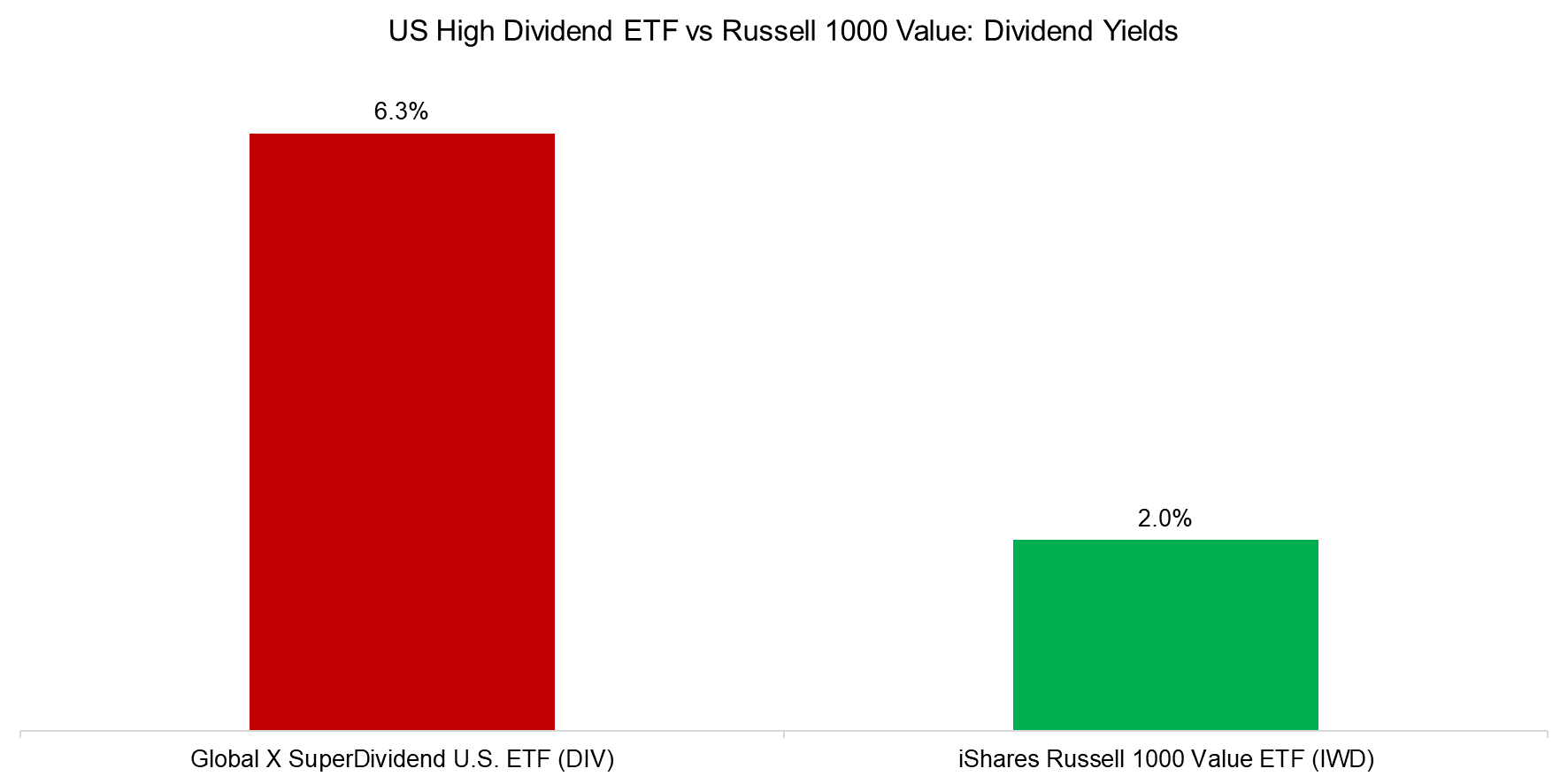
Source: Finominal
But this comparison reveals a 2.5% CAGR for DIV versus 9.0% for the Russell 1000 Value Index between 2013 and 2023. While not an appropriate benchmark, the U.S. stock market as represented by the S&P 500 has done even better with 12.4%.
That DIV basically achieved zero performance over 10 years even as its benchmark doubled and the S&P 500 nearly tripled in value is quite an accomplishment.
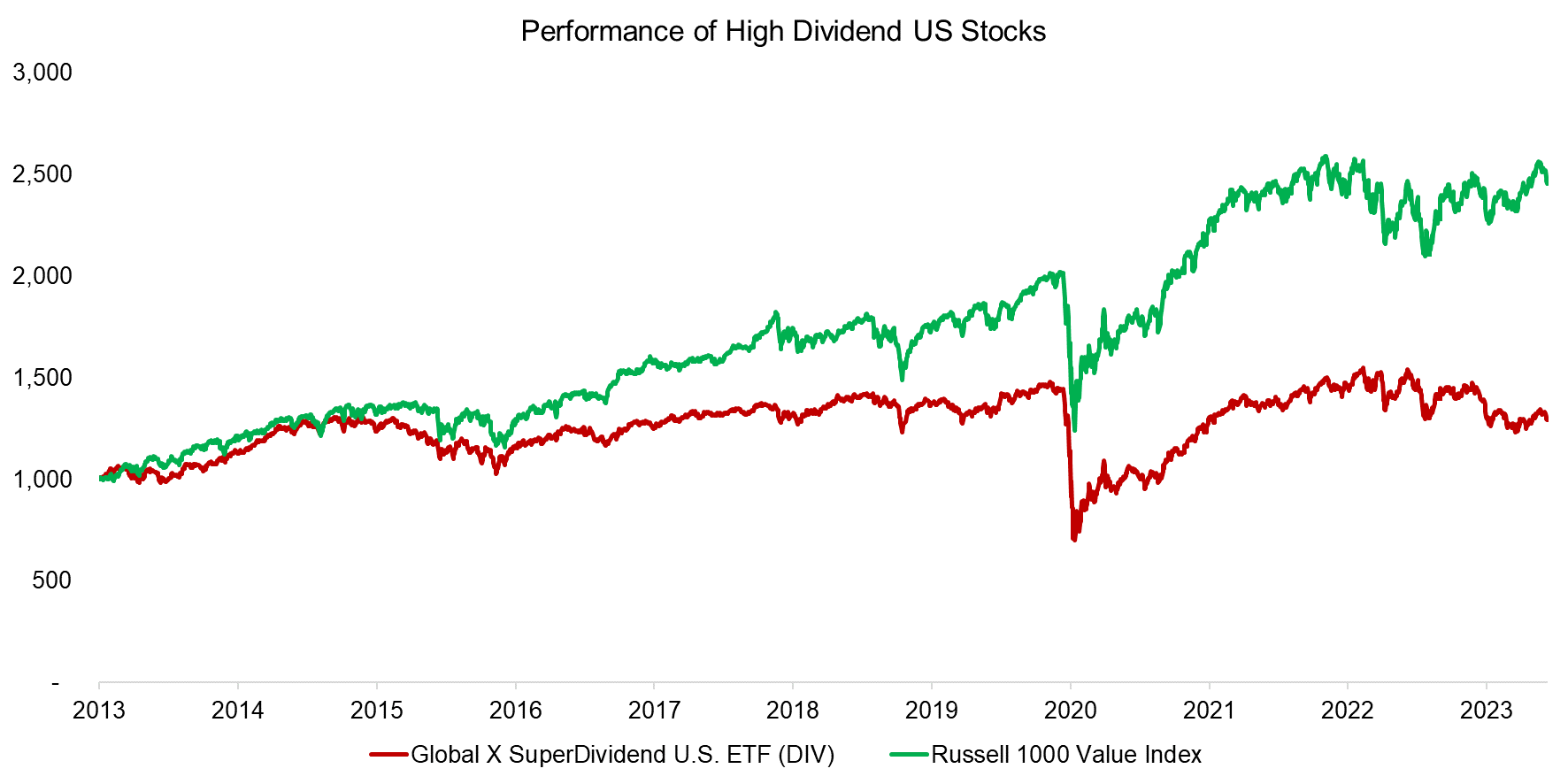
Source: Finominal
RETURN ON VERSUS RETURN OF CAPITAL
When we break DIV’s performance into price and dividend returns, we see that capital investment depreciated from $1,000 in 2013 to $660 in 2023. While DIV did yield positive total returns over the last decade, these all came from dividends.
This demonstrates a poor stock-selection process that allocated capital to troubled companies that nevertheless paid high dividends. Such firms might be overleveraged, have lackluster products, or belong to declining industries. In value-investing lingo, they are value traps – cheap for good reason (read Resist the Siren Call of High Dividend Yields).
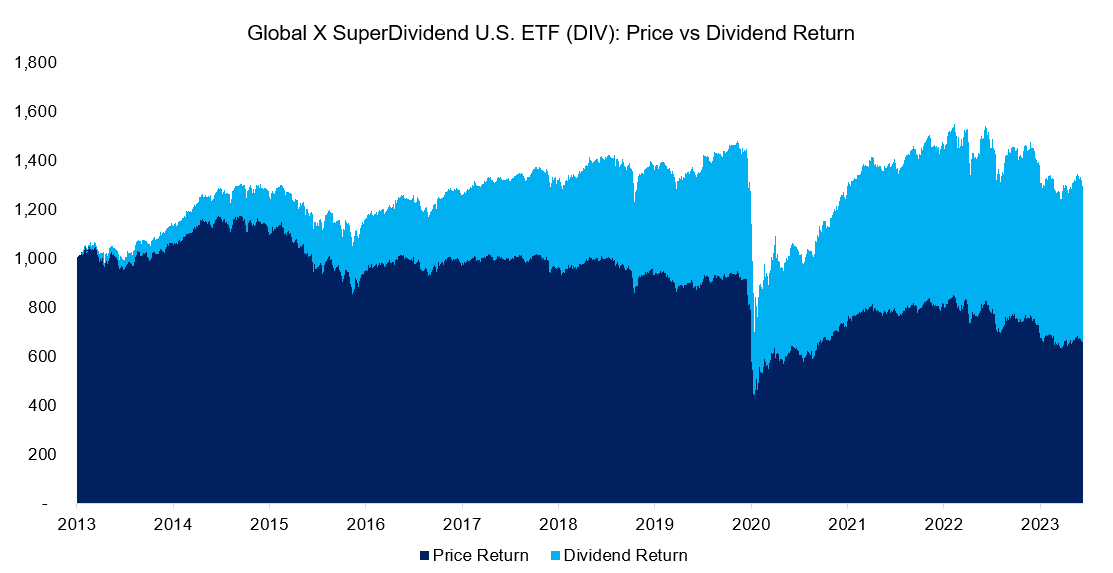
Source: Finominal
SYNTHETIC DIVIDENDS VIA CAPITAL RETURNS
What is a dividend?
It is simply a capital distribution from a company to its shareholders. Nothing more, nothing less. Theoretically, all listed companies could distribute any excess cash not needed for operations or investments back to their shareholders. But many firms – Amazon among them – choose not to. Other companies have negative operating cash flows but pay dividends anyway because shareholders expect them. Rather than pay dividends directly, many US companies have started buying back their shares.
As a rule, investors should purchase companies with growing cash flows instead of focusing on dividends. After all, the dividends a company pays indicate little about the underlying health of the business (read CROIC, CFROI, CROCI & CROCS).
But if we hold a stock, mutual fund, or ETF, we can create our own synthetic dividends by selling part of our investment. Amazon may not pay dividends, but as investors, we can set a desired dividend yield, say 4% per year, and sell the requisite percentage of our Amazon investment on a quarterly basis to realize that 4%. We can increase the dividend yield of the Russell 1000 Value or any index to our desired level through such synthetic dividends.
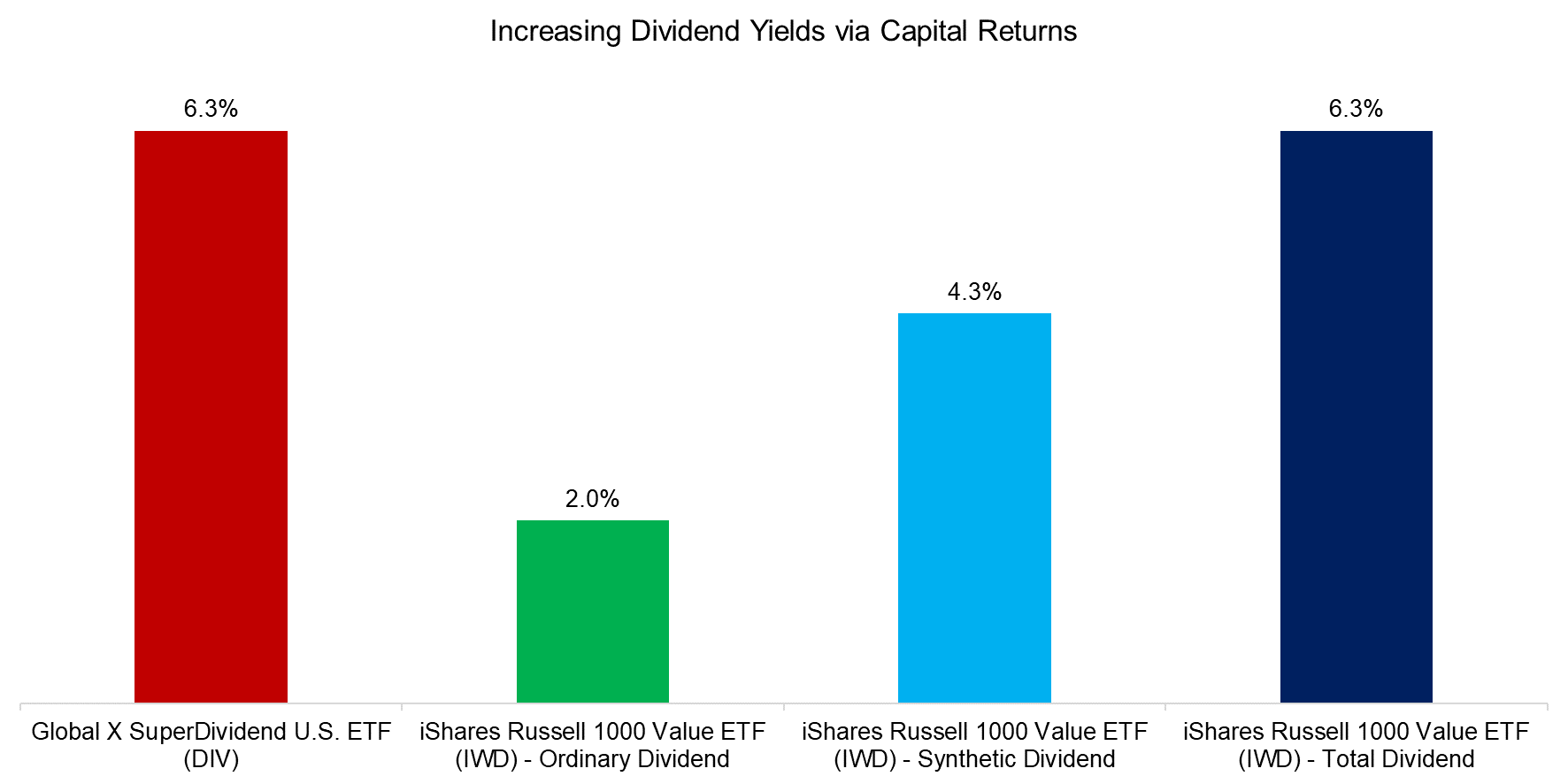
Source: Finominal
TAX CONSIDERATIONS
Of course, the switch from ordinary to synthetic dividends does require some adjustments, mental and otherwise. Since synthetic dividends represent return of rather than return on capital, they are taxed as capital gains instead of dividends and only if the investment was profitable.
While some investors can minimize taxes, through Roth IRAs for example, for many others taxes can still significantly reduce the underlying value of the investment. DIV’s total post-tax return is 13.3% from 2013 to 2023 assuming a 20% dividend tax rate. That compares to a 29.7% pre-tax return.
Investors could have synthetically generated a similarly high dividend yield for the IWD. The pre-tax return would have only declined from 146.0% to 132.9% if we factor in a 15% capital gains tax. This is a much higher return than DIV’s. So, what explains the difference? Most of it is due to the health of the companies in the IWD.
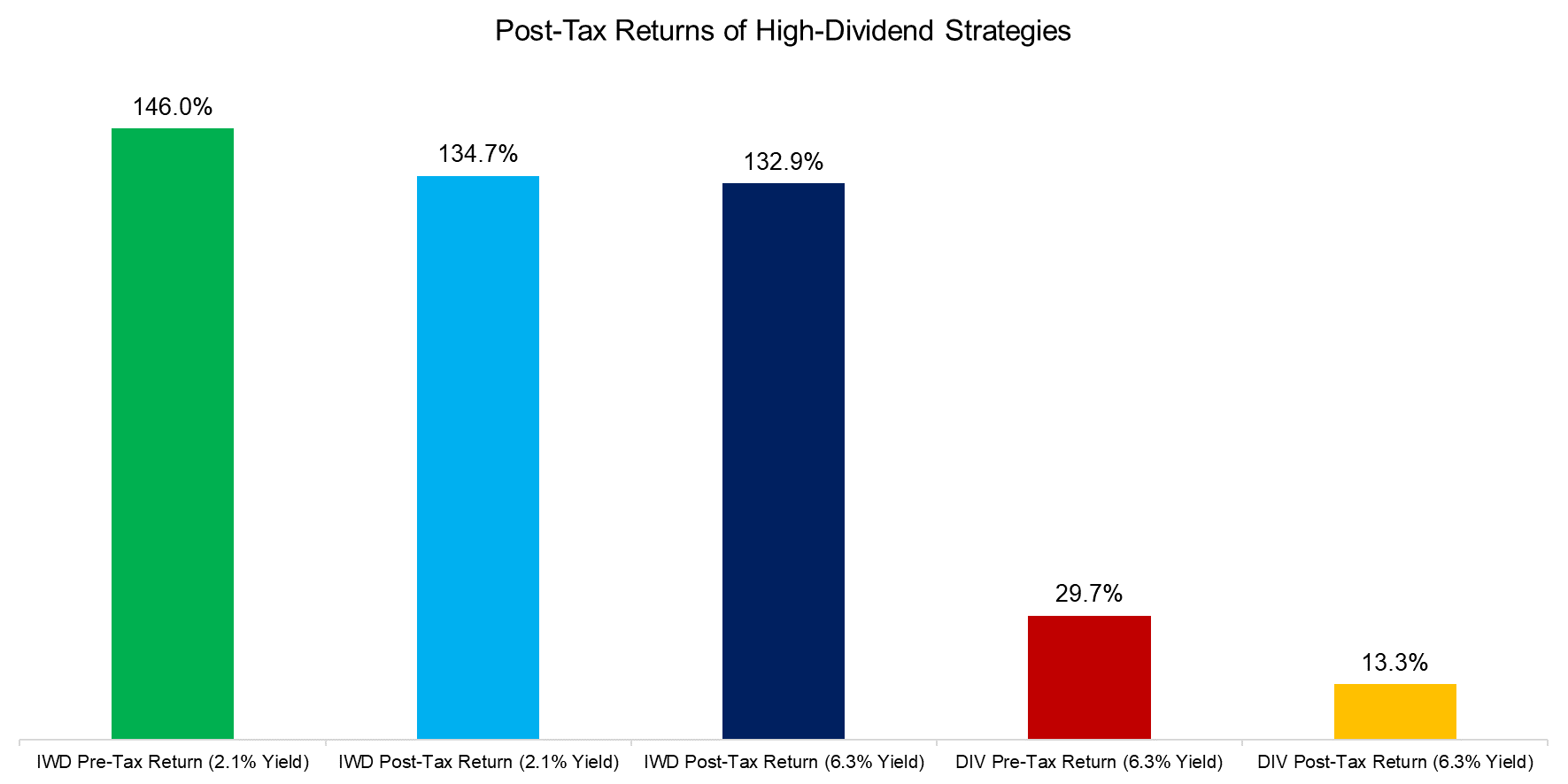
Source: Finominal
FURTHER THOUGHTS
Proponents of traditional dividends might contend that DIV’s lackluster performance was the result of a poor stock selection process. Other products that prioritized dividend growth over yield might have done better. While such an approach might reduce underperformance, it would also lower the dividend yield. For example, the T. Rowe Price Dividend Growth ETF (TDVG) features more than 100-dividend growing stocks but only offers a dividend yield of 1.3%, less than the IWD’s 2%.
The takeaway is clear. Instead of trying to find companies that pay dividends without destroying investment capital, we may be better off taking the S&P 500 or some other benchmark and creating synthetic dividends at our desired yield. In other words, not all financial engineering is bad.
RELATED RESEARCH
BDCs: Better Don’t Choose?
Covered Call Strategies Uncovered
Preferential Times for Preferred Income Strategies?
The Case Against Equity Income Funds
Resist the Siren Call of High Dividend Yields
Dividend Yield Combinations
Value Factor: Improving the Tax Efficiency
Factor Exposure Analysis 101: Linear vs Lasso Regression
ABOUT THE AUTHOR
Nicolas Rabener is the CEO & Founder of Finominal, which empowers professional investors with data, technology, and research insights to improve their investment outcomes. Previously he created Jackdaw Capital, an award-winning quantitative hedge fund. Before that Nicolas worked at GIC and Citigroup in London and New York. Nicolas holds a Master of Finance from HHL Leipzig Graduate School of Management, is a CAIA charter holder, and enjoys endurance sports (Ironman & 100km Ultramarathon).
Connect with me on LinkedIn or X.

